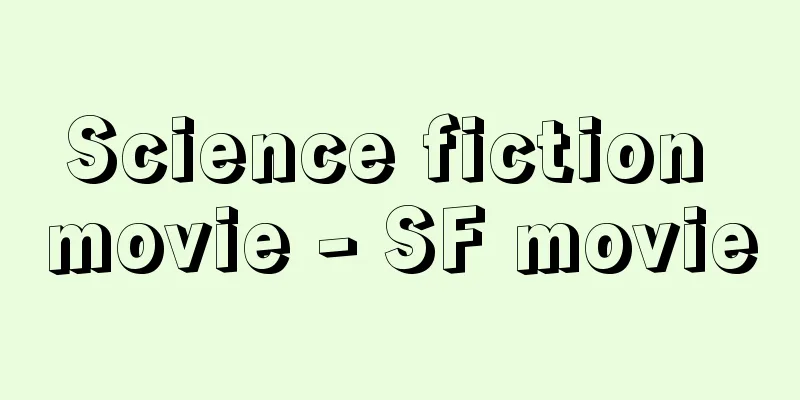Science fiction movie - SF movie

|
Abbreviation for science fiction film. As the name suggests, SF films as a concept are heavily based on the literary genre SF (science fiction), and in practice, SF novels are often adapted into films or SF writers are involved in the scriptwriting. SF films have been created between a tendency to try to tell a certain theme by using settings such as space, lost worlds, future worlds, or aliens arriving on Earth, and a tendency for writers to develop their imaginations by entrusting them to the fantastical sights and strangeness of outer space and alien creatures. Visual effects are always an important element in these films. [Deguchi Taketo] The early daysScience fiction films have appeared as early as the early days of film, when film itself was undergoing trial and error in trying to discover its own characteristics. Many of the works of the Frenchman Georges Méliès, who almost singlehandedly pioneered the latter of the two major characteristics of film - documentary and fantastical - are science fiction-like. A Trip to the Moon (1902) is a representative example. This was followed by Trip to Mars (1917) by the Danish Holgar Madsen (1878-1943), Aelita (1924) by the Russian Yakov Protazanov (1881-1945), and at the end of the silent film era, The Lost World, originally written by Arthur Conan Doyle, was made into a film (1925) by Harry O. Hoyt (1885-1961) in the United States. These works, as dramas linking the ancient and the present, and as the origins of special effects, became the source of Merian Caldwell Cooper (1893-1973) and Ernest Beaumont Schoedsack's (1893-1979) King Kong (1933), and even Steven Spielberg's Jurassic Park (1993). As film became more technologically advanced and science developed, literary figures such as the British writer Aldous Huxley and the Czech writer Karel Capek began to write about the near future, which was not always rosy. Films reflected this trend, such as Fritz Lang's Metropolis (1926) and William Cameron Menzies' (1896-1957) The World to Come (1936), which explored life in the future and its horrors. In both films, the future world was presented as a spotless, modern landscape composed primarily of geometric lines. [Deguchi Taketo] After World War IIAfter the end of World War II, the fear of nuclear war became widespread, while space flight became a reality. Science fiction films also became popular. In particular, in mass-producing countries such as the United States and Japan, popular science fiction films were made and became a genre, and themes such as robots and atomic monsters became widespread. In Godzilla (1954), produced by the golden trio of producer Tomoyuki Tanaka (1910-1997), director Ishiro Honda (1911-1993), and special effects director Eiji Tsuburaya, the terrifying scene in which a monster revived by an atomic bomb experiment attacks a city was based on the fear of the atomic and hydrogen bomb experiments at the time as well as the wartime experiences of Japanese people. In the United States, reflecting the reality of the Cold War, the violent aliens were superimposed on the Soviet Union, as in Robert Wise's (1914-2005) The Day the Earth Stood Still (1951). In fact, in the late 1950s, American society was shocked when the Soviets overtook them in space flight. Meanwhile, Europe produced a number of unique and excellent works, including Chris Marker's (1921-2012) La Jetée (1962), Jean-Luc Godard's Alphaville (1965), François Truffaut's Fahrenheit 451 (1966), and Andrei Tarkovsky's Solaris (1972). Stanley Kubrick's 2001: A Space Odyssey (1968) appeared as a culmination of these Western trends. Making full use of special effects and pursuing a sensory expression, this work influenced not only science fiction films but also the entire flow of film, and it also became a pioneer of science fiction films that were worthy of the power of the large color screen. This was around the time the Apollo spacecraft landed on the moon. [Deguchi Taketo] Post-Star WarsSince the mid-1970s, when Star Wars came out, science fiction movies have been increasingly popular, especially in the United States. As symbolized by the four Alien films (1979-1997), trends have also changed drastically. Major trends include space operas (action dramas set in space) such as George Lucas's Star Wars (1977) and Star Trek series (1979- ), works that deal with communication with aliens such as Spielberg's Close Encounters of the Third Kind (1977) and E.T. (1982), and works that cross the boundary between humans and robots and have human identity as the core of the drama, such as Ridley Scott's (1937- ) Blade Runner (1982), James Cameron's (1954- ) The Terminator (1984) and Terminator 2 (1991), and Spielberg's AI (2001). During this period, the representation of the future world began to change. The clean world of geometric lines that had existed until then was replaced by the Asian city-like alleyways of Blade Runner and the old-fashioned urban areas of Terry Gilliam's (1940- ) Brazil (1985), which shook up the image of the future that had been cultivated in the minds of audiences for many years. The introduction of computer graphics made great strides in special effects in the 1980s. Thanks to the efforts of experts such as Stan Winston (1946-2008), who won an Academy Award for Best Visual Effects for films such as "Aliens" and "Terminator 2," and Dennis Muren (1946- ), who won the same award for films such as "ET" and "Jurassic Park," and the development of Industrial Light & Magic (ILM), a company established at the initiative of Lucas, the visualization of scenes that were impossible in reality became a reality. [Deguchi Taketo] current situationComputer graphics continued to develop and spread, and were even used in dramas unrelated to science fiction, such as Spielberg's "Schindler's List" (1993) and Robert Zemeckis' "Forrest Gump" (1994). Inspired by American films, Japan and other countries also began to adopt this type of visual expression. Special effects, which were once called SFX, were renamed VFX in the 2000s. Using the previous Star Wars trilogy as a core, Lucas began working on a trilogy set in an earlier era, releasing Star Wars: Episode I: The Phantom Menace (1999), Star Wars: Episode II: Attack of the Clones (2002), and Star Wars: Episode III: Revenge of the Sith (2005). In response to the enduring popularity of the series, these films came to be known as the "Star Wars Saga." However, despite these attempts to develop characters based on the existing world, there are now limitations to creating a succession of bizarre characters, modeled after the Star Wars saga, that can resonate with a wide audience. The tendency to compete for the most bizarre things shifted to fantasy films such as Peter Jackson's (1961- ) Lord of the Rings trilogy and the Harry Potter series directed by Chris Columbus (1958- ) and others, and the boom in science fiction films came to a close. Rather, these fantasy films have a sense that is largely similar to science fiction films, and can be considered an extension of science fiction films. As this shows, the boundaries between science fiction films and adjacent genres such as horror and fantasy are becoming ambiguous. On the other hand, works such as Starship Troopers (1997) by Paul Verhoeven (1938- ), Minority Report (2002) and War of the Worlds (2005) by Spielberg, which are reminiscent of the traditional orthodox world of science fiction, are based on science fiction (novels) from the 1950s, respectively, such as the film adaptation of Robert Heinlein's original story (Starship Troopers), Philip K. Dick's short story (Minority Report), and H. G. Wells' classic (War of the Worlds). They are not original works of modern times. The conditions for the existence of early science fiction, which attempted to depict the human condition by using the unreachable world of space as a mirror, were fundamentally overturned as space development became a reality. The form of science fiction that reflects this situation must also change. In this context, the focus has recently shifted to inner or personal adventures in which characters travel between reality and dreams or fantasies, between the past and the present, and between the world and another world, or so-called "other world." A representative work is the trilogy "The Matrix" (2001), "The Matrix Reloaded" (2003), and "The Matrix Revolutions" (2003), directed by brothers Andy Wachowski (1967-) and Larry Wachowski (1965-). This series, which is said to have been inspired by the writings of Jean Baudrillard, which are full of insight into modern consumer society, has recently become the subject of consideration of contemporary thought. [Deguchi Taketo] "Super Science Fiction Films" edited by Shinji Nakako (1980, Kisoutengaisha)" ▽ "The World of Science Fiction Films" edited by Akihiro Kitajima (1991, Kindaieigasha)" ▽ "The Complete Guide to Bizarre Science Fiction Films" edited by Ronald V. Borst et al., translated by Masako Komazuki (1997, Kokushokankokai)" ▽ "100 Years of Foreign Films in Photos 6: Science Fiction Films that Jump into Space - 1972-1984" commented by Juzaburo Futaba (1997, Kindaieigasha)" ▽ "SF MOVIES - The Past and Future of Science Fiction Films" (2002, Neko Publishing) ▽ "The Philosophy of the Matrix" edited by William Irwin, translated by Shunsuke Matsuura and Akie Onogi (2003, Byakuya Shobo)" ▽ "The Genealogy of American Science Fiction Films - Myths of Space Exploration and Myths of Alien Invasion" by Koichi Hasegawa (2005, Rim Publishing Co., Ltd.) ▽ "The Complete History of Science Fiction Films in the World" by Kitajima Akihiro (2006, Aikusha) ▽ "Adventures in Science Fiction Films" by Ishigami Mitoshi (Shincho Bunko) ▽ "Cult Cinema Science Fiction" edited by Nagata Yoshinori (Shakai Shisosha, Gendai Kyoyo Bunko) ▽ "A Selection of Science Fiction Films You'll Want to Watch Again and Again" by Kitajima Akihiro (Kodansha Plus Alpha Bunko) [References] | | | | | | | | | | | | | | | | | | | | | | | |Source: Shogakukan Encyclopedia Nipponica About Encyclopedia Nipponica Information | Legend |
|
サイエンス・フィクション・フィルムscience fiction filmの略称。その名のとおり概念としてのSF映画は文学の一ジャンルであるSF(空想科学小説)に基づくところが大きく、実際面でもSF小説の映画化ないしSF作家がシナリオに参加する場合が多い。SF映画は、宇宙、ロストワールド(失われた世界)、未来世界などの舞台あるいは異星人の地球飛来という状況設定を借りて、あるテーマを語ろうとする傾向と、宇宙空間や異生物のもつ幻想的光景や怪異性に託して作家が想像力を展開させる傾向との間で作品が生まれてきた。そこでは視覚的な効果がつねに重要な要素となる。 [出口丈人] 草創期SF映画は、映画そのものが自己の特性をみいだそうと試行錯誤を重ねていた草創期から早くも現れている。記録性と幻想性という映像の二大特性のうち幻想性の開拓を、ほとんど1人で成し遂げたフランスのジョルジュ・メリエスの作品にSF的な作品が多い。『月世界旅行』(1902)はその代表作である。その後、デンマークのホルガー・マッスンHolgar Madsen(1878―1943)による『火星旅行』(1917)、ロシアのヤコフ・プロタザーノフYakov Protazanov(1881―1945)による『アエリータ』(1924)などに続き、無声末期になると、アメリカではコナン・ドイル原作の『ロスト・ワールド』がハリー・O・ホイトHarry O. Hoyt(1885―1961)により映画化(1925)された。これらの作品は太古と現在が結び付くドラマとして、また特殊撮影の一つの原点として、メリアン・コールドウェル・クーパーMerian Coldwell Cooper(1893―1973)およびアーネスト・ボーモント・シェードザックErnest Beaumont Schoedsack(1893―1979)の『キング・コング』(1933)、そして遠くスティーブン・スピルバーグの『ジュラシック・パーク』(1993)に至る源流となった。 映画が技術的に進歩し、また科学の発展によって、イギリスの作家オルダス・ハクスリーやチェコの作家カレル・チャペックのように文学者が近未来的な、それもかならずしもバラ色でない内容の作品を書くような時代になると、映画にもそれを反映した作品が生まれてくる。フリッツ・ラングの『メトロポリス』(1926)、ウィリアム・キャメロン・メンジースWilliam Cameron Menzies(1896―1957)の『来たるべき世界』(1936)は未来の生活とその恐怖に踏み込んだ作品である。そして未来世界は、どれも幾何学的な線を主体に構成された塵(ちり)一つないモダンな光景として提示された。 [出口丈人] 第二次世界大戦後第二次世界大戦が終わり、核戦争の恐怖が一般化し、一方では宇宙飛行が現実化してくると、SF映画も一般化してくる。とくにアメリカ、日本など映画の量産国では、通俗的なSF映画がつくられ、一ジャンルをなすようになり、ロボット、原子怪獣など題材も広がってくる。製作・田中友幸(1910―1997)、監督・本多猪四郎(1911―1993)、特撮監督・円谷英二(つぶらやえいじ)の黄金トリオによる『ゴジラ』(1954)の、原爆実験によりよみがえった怪獣が都会を襲う恐怖のシーンは、おりからの原水爆実験の恐怖と同時に日本人の戦争体験がベースになっている。アメリカでは現実の冷戦を反映し、ロバート・ワイズRobert Wise(1914―2005)の『地球の静止する日』(1951)のように、凶暴な宇宙人はソビエトに重ねあわせられた。実際1950年代末には、ソビエトに宇宙飛行で先を越されるというアメリカ社会にショックを与えた状況があった。 一方ヨーロッパでは、クリス・マルケルChris Marker(1921―2012)の『ラ・ジュテ』(1962)、ジャン・リュック・ゴダールの『アルファヴィル』(1965)、フランソワ・トリュフォーの『華氏451』(1966)、アンドレイ・タルコフスキーの『惑星ソラリス』(1972)など個性的で優れた作品が現れた。 これら欧米の流れを集大成するように現れたのがスタンリー・キューブリックの『2001年宇宙の旅』(1968)である。特殊効果を駆使し体感的な表現を追求したこの作品は、SF映画にとどまらず映画の流れそのものに影響を与えているが、カラーの大画面の威力にふさわしいSF映画の先駆ともなった。それはアポロ宇宙船が月面に着陸したころのことであった。 [出口丈人] 『スター・ウォーズ』以後『スター・ウォーズ』の登場した1970年代中盤以後、SF映画はアメリカを中心にますます隆盛をみせた。『エイリアン』全4作(1979~97)が象徴しているように、傾向も多様に移り変わっている。ジョージ・ルーカスの『スター・ウォーズ』(1977)や『スタートレック』シリーズ(1979~ )などのスペース・オペラ(宇宙を舞台にした活劇)、スピルバーグの『未知との遭遇』(1977)、『E.T.』(1982)などの異星人とのコミュニケーションを問題にするもの、リドリー・スコットRidley Scott(1937― )の『ブレードランナー』(1982)、ジェームズ・キャメロンJames Cameron(1954― )の『ターミネーター』(1984)、『ターミネーター2』(1991)、スピルバーグの『A.I.』(2001)など人間とロボットの境界を通し人間のアイデンティティをドラマの核とする作品などの主要な傾向がある。 この時期には、未来世界の表象が変わり始めた。それまでの幾何学的な線による清潔な世界にかわり、『ブレードランナー』のアジアの町中のような路地や、テリー・ギリアムTerry Gilliam(1940― )の『未来世紀ブラジル』(1985)のどこか昔風の都会などが現れて、長年にわたり観客のなかに醸されてきた未来のイメージを揺すぶった。 コンピュータ・グラフィクスの導入により、1980年代の特殊効果は大きく前進した。『エイリアン2』『ターミネーター2』などでアカデミー視覚効果賞を受賞したスタン・ウィンストンStan Winston(1946―2008)、『E.T.』『ジュラシック・パーク』などで同賞を受賞したデニス・ミューレンDennis Muren(1946― )らの専門家の活躍や、ルーカスの肝いりで設立されたILM(Industrial Light & Magic:インダストリアル・ライト&マジック)社の発展などによって、現実には不可能なシーンの視覚化が次々と実現されていった。 [出口丈人] 現状その後もコンピュータ・グラフィクスは発達・普及を続け、スピルバーグの『シンドラーのリスト』(1993)、ロバート・ゼメキスの『フォレスト・ガンプ/一期一会(いちごいちえ)』(1994)など、SFとは無関係なドラマに使われるまでになった。またアメリカ映画に刺激を受けて日本をはじめとする各国もこのような映像表現を取り入れるようになった。かつてSFXと呼び習わされていた特殊効果も、2000年代に入ったころからVFXといいかえられた。 ルーカスはそれまでの『スターウォーズ』三部作を核に、それ以前の時代を舞台にした三部作に着手し、『スターウォーズ エピソード1/ファントム・メナス』(1999)、『スター・ウォーズ エピソード2/クローンの攻撃』(2002)、『スター・ウォーズ エピソード3/シスの復讐』(2005)を発表、根強い人気にこたえ、これらの作品群は「スターウォーズ・サガ」ともよばれるようになった。 しかし既存の世界をもとにキャラクターをその先へと展開させるこうした試みの一方で、「スターウォーズ・サガ」が手本となった異形のキャラクターを、幅広い観客の共感を得る範囲で次々に生み出すことに限界がみえてきた。 異形を競う傾向はむしろピーター・ジャクソンPeter Jackson(1961― )の『ロード・オブ・ザ・リング』三部作やクリス・コロンバスChris Columbus(1958― )他監督の「ハリー・ポッター・シリーズ」などのファンタジーに移り、それまでのSF映画のブームは一段落した。というよりも、こうしたファンタジー映画には多分にSF映画に通じる感覚が認められ、SF映画の延長とみなすこともできる。このことが示すように、SF映画とホラー、ファンタジーなど隣接ジャンルとの境界はあいまいなものになってきている。 一方、従来の正統的SF世界を思わせるポール・バーホーベンPaul Verhoeven(1938― )の『スターシップ・トゥルーパーズ』(1997)、スピルバーグの『マイノリティ・リポート』(2002)、『宇宙戦争』(2005)などの作品は、それぞれロバート・ハインラインの原作の映画化(『スターシップ・トゥルーパーズ』)、フィリップ・K・ディックの短編(『マイノリティ・リポート』)、H・G・ウェルズの古典(『宇宙戦争』)と、いずれも、1950年代までのSF(小説)に基づくもので、現代のオリジナルではない。宇宙という到達不可能な世界を鏡として人間の姿を描こうとするものであった初期のSFの存立条件は、宇宙開発の現実化が進行するにつれ、根底から覆された。そうした状況を反映するSFの姿もまた変わらざるをえない。 そのようななかで、最近の中心は、現実と夢あるいは幻想、過去と現在、世界ともう一つの世界、いわゆるアナザー・ワールドなどを登場人物が往還する、内面的ないし個人的な冒険に移ってきている。代表的な作品はアンディ・ウォシャウスキーAndy Wachowski(1967― )とラリー・ウォシャウスキーLarry Wachowski(1965― )兄弟が監督した『マトリックス』(2001)、『マトリックス・リローデッド』(2003)、『マトリックス・レボリューションズ』(2003)の三部作である。現代の消費社会ヘの洞察に満ちたジャン・ボードリヤールの著作にインスパイアされたといわれるこのシリーズは、最近では、逆に現代思想の考察の対象ともなっている。 [出口丈人] 『中子真治編著『超SF映画』(1980・奇想天外社)』▽『北島明弘監修『SF映画の世界』(1991・近代映画社)』▽『ロナルド・V・ボースト他編、駒月雅子訳『怪奇SF映画大全』(1997・国書刊行会)』▽『双葉十三郎解説『写真で見る外国映画の100年 6 宇宙へ飛び出すSF映画――1972~1984』(1997・近代映画社)』▽『『SF MOVIES―SF映画の過去と未来』(2002・ネコ・パブリッシング)』▽『ウィリアム・アーウィン編著、松浦俊輔・小野木明恵訳『マトリックスの哲学』(2003・白夜書房)』▽『長谷川功一著『アメリカSF映画の系譜――宇宙開拓の神話とエイリアン来襲の神話』(2005・リム出版新社)』▽『北島明弘著『世界SF映画全史』(2006・愛育社)』▽『石上三登志著『SF映画の冒険』(新潮文庫)』▽『永田よしのり編『カルト映画館 SF』(社会思想社・現代教養文庫)』▽『北島明弘著『何回でもみたくなるSF映画選集』(講談社プラスアルファ文庫)』 [参照項目] | | | | | | | | | | | | | | | | | | | | | | | |出典 小学館 日本大百科全書(ニッポニカ)日本大百科全書(ニッポニカ)について 情報 | 凡例 |
Recommend
network protocol
The communication procedures and rules in network ...
Kyodo Printing Dispute
In 1926 (Taisho 15), a major dispute led by the J...
Wang Gao
...It consists of four volumes. It was compiled b...
"Kiyohara no edaka kataoku gakishiki mokushō" - Kiyohara no edaka kataoku gakishiki mokushō
...The author, Kiyohara Nobukata, can be said to ...
Mascezel
…In 397, he sailed to the Peloponnese to suppress...
Modern Thought
A literary and ideological magazine published by ...
Julien Sorel
The protagonist of the novel The Red and the Black...
Kinugawa Gakuin
…It is an expansion of the target of the previous...
International Conference of Scientific Union
Founded in 1931, it is a non-governmental, non-pro...
Secured Bonds - TANPOTSUKI SHAI
A bond with a security attached to it. It is the ...
Reduced writing - Genpitsu
Originally, it meant writing characters without s...
Sibiu (English spelling)
Sibiu is the capital of Sibiu County (area 5,422 k...
Kimonology - Kimonology
...A school of thought advocated by the early mod...
Parasitic fungus
This refers to bacteria that are involved in biod...
Black alkali soil
...An experiment in Nevada, USA (1962) reported t...









